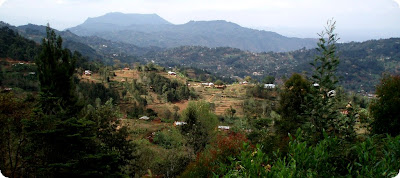When I awoke on Sunday morning, the world had disappeared, which was really quite a shame. The previous evening, I had perched upon a deeply weathered boulder just below the summit of Kindoroko peak in the Pare Mountains
The Massai Steppe stretched away into the middle distance where Nyumba ya Mungu Reservoir shimmered sleepily. Far, far away, peeking over the horizon through its own orange haze, sprawled a seductively rugged-looking mountain range. And beside me, an ornate, horned spider bided its time at the centre of a web strung between the bracken fronds.
But overnight, a chilly mist erased everything. Our tents clung limply to the rough grass of an uneven clearing. It was just before dawn and the hope of catching the sunrise had coaxed me from warm dreams and an even warmer sleeping bag. I had imagined the first light of dawn cutting through the crisp morning air to highlight the distant pyramidal peaks of the Hanang range, but those hopes now lay in sodden tatters on the dew soaked turf.
What's more, it was cold in the high altitude mist and the porridge wasn’t ready yet so I retreated into my fantasy world where a crisply dressed waiter stood with a towel over his arm seducing me with the breakfast menu. In my fantasy world, I had already enjoyed a warm shower in a bathroom sparkling with white porcelain; the newspaper lay half read on the table and the slightest nod was enough to summon fresh coffee…
As the waiter’s brisk footsteps receded, I indulged myself with a slideshow of memories from the previous day. The truck had taken us up and over the Pare range on a road that gripped the hillsides like a twist of celestial spaghetti flung carelessly across the landscape.
Our drop off was Lomwe village, close to the birthplace of David Msuya. It comprised an assortment of buildings scattered across a wide valley floor and lay confined beneath a ring of soaring peaks. It took all afternoon to climb the calf-wrenching red-soil paths that led us through tiny farm plots until we reached the almost untouched woodland that thrives above 1800 metres.
An hour before sunset, we had reached the highest point in the
But there was nothing to linger for the following morning. With the tents struck and the porridge eaten, or rather drunk (memo required regarding oats to water ratio), we slithered off the edge of Kindoroko onto a treacherously steep path. Damp leaves and perilous roots littered the knee-jarringly precipitous trail and the world was lost in an eerie, mist muffled silence. But that was okay because in my fantasy world birds twittered and an escalator whisked me sedately down through a centrally heated, virtual mountain experience.
Then suddenly, the cloud lifted and the real world took centre stage. I dropped back from the herd and as the thundering hooves of twenty trekkers faded into the distance, real birds started to tweet. If I knew my birds, I may have been able to identify the call of an Olive Woodpecker, Moustached Green-tinkerbird or perhaps an African Hill Babbler – just a few of the exotic sounding species common in the North Pare. But I happily skipped the twitcher’s checklist in favour of a rainbow of unidentified, colourful flashes flitting through lichen laden branches.
For the remainder of the hike, my fantasy world lay largely unexplored as our descent meandered through isolated small-holdings; chickens scurried off the path ahead of us, clucking their reproach and mud bricks lay baking in the sun or piled high waiting to be fired. Eventually the trail levelled off and I tramped a dusty track flanked by the vicious spikes of katani (sisel) succulents, whose tough fibres are spun into course rope.
Finally we wandered the eroded dirt streets of Lembeni, a dusty hamlet straddling the Dar road. A tiny grocery store bore the name ‘Simple Store’. I wondered if the name referred to the stock or the merchant. Or maybe only simple clients are served. I didn't stop, just in case. Parked nearby was a lorry with ‘Man to Man Truck’ emblazoned across the top of its windscreen. Perhaps 'Man' is a place and the lorry plies a circular route. Or maybe the driver offers more than just haulage. I quickened my step, just in case.
Did you come here from the Backpacker Diaries? Click here to return.
Did you enjoy reading this post? Why not leave a comment?
Follow this blog to keep up to date with new posts, or share it with friends using one of the buttons below...







Did you enjoy reading this post? Why not leave a comment?
Follow this blog to keep up to date with new posts, or share it with friends using one of the buttons below...



*****
Breakfast image sourced from Wikipedia and reproduced under the terms of the Creative Commons Licence.
All other images (c) Jon Bigg
Breakfast image sourced from Wikipedia and reproduced under the terms of the Creative Commons Licence.
All other images (c) Jon Bigg










Wow, looking back at all these images of Fraser here in Moshi... Memories flooding back
ReplyDelete